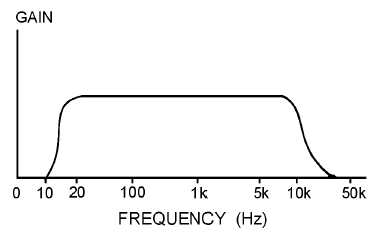1-25
Figure 1-22.—Ideal frequency response curve for an audio amplifier.
The difference between an audio amplifier and other amplifiers is the frequency response of the
amplifier. In the next chapter of this module you will be shown the techniques and components used to
change and extend the frequency response of an amplifier.
The transistor itself will respond quite well to the audio frequency range. No special components are
needed to extend or modify the frequency response.
You have already been shown the purpose of all the components in a transistor audio amplifier. In
this portion of the chapter, schematic diagrams of several audio amplifiers will be shown and the
functions of each of the components will be discussed.
SINGLE-STAGE AUDIO AMPLIFIERS
The first single-stage audio amplifier is shown in figure 1-23. This circuit is a class A,
common-emitter, RC-coupled, transistor, audio amplifier. C1 is a coupling capacitor that couples the
input signal to the base of Q1. R1 is used to develop the input signal and provide bias for the base of Q1.
R2 is used to bias the emitter and provide temperature stability for Q1. C2 is used to provide decoupling
(positive feedback) of the signal that would be developed by R2. R3 is the collector load for Q1 and
develops the output signal. C3 is a coupling capacitor that couples the output signal to the next stage. VCC
represents the collector-supply voltage. Since the transistor is a common-emitter configuration, it provides
voltage amplification. The input and output signals are 180º out of phase. The input and output impedance
are both medium.

